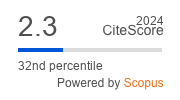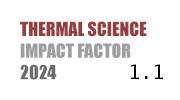THERMAL SCIENCE
International Scientific Journal
Thermal Science - Online First
online first only
Indoor-outdoor concentration of particulate matter in a lead-zinc mine: A case study from China
ABSTRACT
Due to the unique environment of mines, there are significant differences in pollutants in different production and operation locations. This paper takes a case study mine to test and study the distribution of indoor and outdoor particulate matter mass concentration, particle number concentration in three measurement locations, and conduct in-depth analysis of its pollution status and differentiated impact. The results indicated in different locations, the concentration of particle sizes less than 0.3 μm is higher, and the concentration of range of particle sizes is higher indoor than outdoor. The office area has the highest I/On value of 1.27 at a particle size of 0.29, the dormitory area also has the highest I/On value of 1.31 at a particle size of 0.29, and the flotation plant has the highest I/On value of 4.85 at a particle size of 0.375. The mass concentration of indoor and outdoor particulate matter in the flotation plant is higher than that in the office area and dormitory area, with only the concentration in the flotation plant exceeding the standard. The I/Oc values in different locations are all greater than 1, and the indoor particulate matter concentration is higher than that outdoors. The outdoor particulate matter concentration is mainly affected by indoor particulate matter. It can provide reference value for the safe construction of mining environment.
KEYWORDS
PAPER SUBMITTED: 2025-04-19
PAPER REVISED: 2025-05-28
PAPER ACCEPTED: 2025-06-04
PUBLISHED ONLINE: 2025-07-05
- Song, Y., et al., Transitioning the mining industry to a greener economy: An Asian perspective of mineral demand. Resources Policy, 102, (2025), pp. 105483
- Gao, X., et al., Profiles and Source Apportionment of PAHs in Particulate Matter from Resuspended Dust in Coal Mining Areas: Implications for Atmospheric Pollution. Atmospheric Pollution Research, 4, (2025), pp. 102434
- Zheng, L., et al., Measurement of diesel particulate matter in coal mine using a multi-channel optical extinction method. Fuel, 388, (2025), pp. 134545
- Qingsong, M., et al., Global burden of pneumoconiosis attributable to occupational particulate matter, gasses, and fumes from 1990~2021 and forecasting the future trends: a population-based study. Frontiers in Public Health, 12, (2025), pp. 1494942
- Tariq, H., et al., State-of-the-Art Low-Cost Air Quality Sensors, Assemblies, Calibration and Evaluation for Respiration-Associated Diseases: A Systematic Review. Atmosphere, 15, (2024), pp. 471
- Norbu, N., et al., Effect of Heating Emissions on the Fractal Size Distribution of Atmospheric Particle Concentrations. Atmosphere, 15, (2024), pp. 95
- Zhang, X., et al., Comparison of the Application of Three Methods for the Determination of Outdoor PM2.5 Design Concentrations for Fresh Air Filtration Systems in China, International Journal of Environmental Research and Public Health, 19, (2022), pp. 16537
- Deng, Y., et al., Characteristics of atmospheric dustfall fluxes and particle size in an open pit coal mining area and surrounding areas. Scientific Reports, 15, (2025), pp. 9597
- Singh, V.V., et al., Seasonal impact of particulate matter exposure on urinary health of mine workers in iron ore mining environment. Geosystems and Geoenvironment, 4, (2025), pp. 100342
- Bagheri, G., et al., Size, concentration, and origin of human exhaled particles and their dependence on human factors with implications on infection transmission, Journal of Aerosol Science, 168, (2023), pp. 106102
- Fan, J.N., et al., Comprehensive Review of Spray and Ventilation Technologies for Coal Dust Control at Mining Faces. Process Safety and Environmental Protection, 195, (2025), pp. 106799
- Sesay, M., et al., The Influence of Conical Pick Cutter Wear Conditions on Physical Characteristics and Particle Size Distribution of Coal: Health and Safety Considerations with a Focus on Silica. Minerals, 15, (2025), pp. 182
- Flores-Castañeda, R.O., et al., Technological advances and trends in the mining industry: a systematic review. Mineral Economics, (2024), pp. 1-16
- Shen, Y., Zhang, X., Blue sky protection campaign: Assessing the role of digital technology in reducing air pollution. Systems, 12, (2024), pp. 55
- Li, L., et al., How does the impact of a two-stage air pollution control policy on air quality different? Evidence from 258 cities in China. Atmospheric Pollution Research, 15, (2024), pp. 102148
- Zhang, J., et al., Research status of comprehensive utilization of coal-based solid waste (CSW) and key technologies of filling mining in China: A review. Science of the Total Environment, 926, (2024), pp. 171855
- Song, H., et al., Concentration Characteristics and Correlations with Other Pollutants of Atmospheric Particulate Matter As Affected by Relevant Policies, International Journal of Environmental Research and Public Health, 20, (2023), pp. 1051
- National Standard of the People's Republic of China. GB 3095-2012: Ambient Air Quality Standards. China Environmental Science Press: Beijing, China, 2012
- Zhou, T. Y., et al., Study on the distribution of particulate matter concentration in a lead-zinc flotation plant and its impact, Gold, 9 (2024), pp. 87-91. (In Chinese)
- Wei, Y., et al., Outdoor design PM2.5 concentration method for fresh air systems based on dual-carbon target: A case study of urban economic regions from China. Thermal Science, 28 (2024), pp. 3141-3154
- Liu, F., et al., Distribution and Fractal Characteristics of Outdoor Particles in High-Rise Buildings Based on Fractal Theory. Fractal and Fractional, 7, (2023), pp. 669
- Gui, C., et al., Effects of fine particulate matter bound heavy metals on intentional self-harm deaths in Guangzhou, China, insight from core chemical constituents. International Journal of Biometeorology, 69, (2025), pp. 357-365
- Liu, Y., et al., Characteristics, Sources, Exposure, and Health Effects of Heavy Metals in Atmospheric Particulate Matter. Current Pollution Reports, 11, (2025), pp. 16
- Zhen, Q., et al., A Markov chain-based approach for assessing respiratory infection risk in a multi-zone office building. Journal of Building Engineering, 90, (2024), pp. 109328
- Chen, C., Zhao, B. Review of relationship between indoor and outdoor particles: I/O ratio, infiltration factor and penetration factor. Atmospheric environment, 45, (2011), pp. 275-288
- Rojano, R., et al., Indoor/outdoor relationship of particulate matter (PM10) and its chemical composition in a coastal region of Colombia. Case Studies in Chemical and Environmental Engineering, 8, (2023), pp. 100397
- Wu, S., et al., Investigation into hydrogen induced fracture of cable bolts under deep stress corrosion coupling conditions. Tunnelling and Underground Space Technology, 147, (2024), pp. 105729
- Wu, S., et al., Investigation into durability degradation and fracture of cable bolts through laboratorial tests and hydrogeochemical modelling in underground conditions. Tunnelling and Underground Space Technology, 138, (2023), pp. 105198
- Wu, S., et al., Characterisation of stress corrosion durability and time-dependent performance of cable bolts in underground mine environments. Engineering Failure Analysis, 150, (2023), pp. 107292

